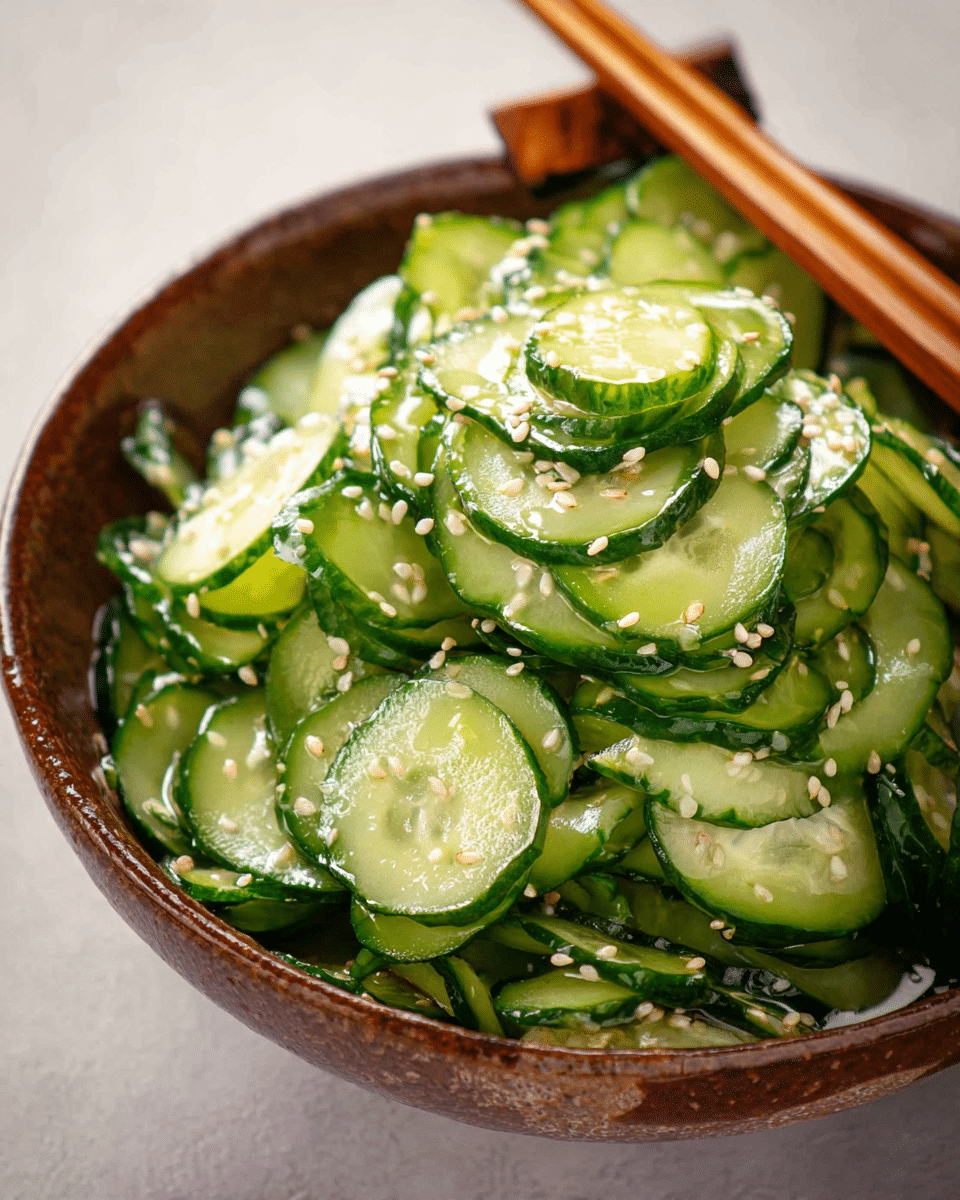This Japanese Cucumber Salad, also known as Sunomono, is the epitome of simplicity and balance. Its lightness and crisp texture offer a refreshing contrast to heavier main dishes, while the sweet-and-tangy rice vinegar dressing invigorates the palate. With just a handful of ingredients and minimal preparation, this salad comes together in minutes, yet feels elegant enough to accompany a sushi dinner or any Japanese-inspired meal.
Perfectly chilled and topped with sesame seeds, this dish shines as a quick appetizer, side dish, or healthy snack. You can customize it by adding rehydrated wakame seaweed or sliced seafood for an extra layer of umami. Whether served at a backyard barbecue or part of a minimalist dinner, Sunomono delivers bright flavor in every bite.
Full Recipe:
Ingredients:
-
2 Japanese cucumbers or Persian cucumbers, thinly sliced
-
1 teaspoon salt
-
3 tablespoons rice vinegar
-
1 tablespoon sugar
-
1 teaspoon soy sauce
-
1 teaspoon sesame oil
-
1 tablespoon toasted sesame seeds
-
Optional: sliced wakame seaweed, imitation crab sticks, or shrimp
Directions:
-
Place the thinly sliced cucumbers in a bowl, sprinkle with salt, and mix well. Let sit for 10 minutes to draw out excess water.
-
After 10 minutes, gently squeeze the cucumbers to remove moisture, then set aside.
-
In a separate bowl, whisk together rice vinegar, sugar, soy sauce, and sesame oil until sugar is fully dissolved.
-
Add the drained cucumbers to the dressing and mix until evenly coated.
-
Garnish with toasted sesame seeds and any optional toppings like wakame or seafood.
-
Chill in the refrigerator for at least 10 minutes before serving for maximum flavor.
Prep Time: 10 minutes | Cooking Time: 0 minutes | Total Time: 10 minutes
Kcal: 60 kcal | Servings: 2 servings
Japanese Cucumber Salad, traditionally known as Sunomono, is a simple yet elegant dish that captures the essence of Japanese cuisine: balance, harmony, and freshness. Often served as a small appetizer or a side dish, Sunomono is celebrated for its light, tangy flavor and crisp texture, making it a perfect palate cleanser and a complement to savory main courses like sushi, grilled fish, or tempura.
Despite its humble list of ingredients, this dish delivers a surprising complexity of taste and texture. From its characteristic rice vinegar dressing to its sesame-scented finish, every bite offers a burst of umami and refreshment. If you’re looking to bring a touch of Japanese culinary tradition into your own kitchen, Sunomono is an easy and rewarding recipe to start with.
The Origin and Cultural Significance of Sunomono
Sunomono (酢の物), which literally translates to “vinegared things,” is a category of Japanese dishes dressed primarily with rice vinegar-based sauces. These dishes are often enjoyed as side accompaniments, especially in traditional kaiseki meals a multi-course dining experience that highlights seasonal ingredients and subtle flavors.
In Japan, balance is the cornerstone of culinary philosophy. Sunomono plays a vital role by offering a bright and acidic contrast to richer dishes. Its inclusion in a meal isn’t just about flavor it serves to awaken the palate, stimulate digestion, and refresh the senses. You’ll often find variations of sunomono that include seafood, seaweed, or other vegetables, but the cucumber version remains one of the most popular for its accessibility, minimal preparation, and crisp, clean flavor.
The Art of Simplicity in Japanese Cooking
One of the most appealing aspects of Japanese cucumber salad is its simplicity. With just a handful of ingredients typically cucumbers, rice vinegar, sugar, soy sauce, and sesame oil it’s amazing how this salad manages to stand out. The cucumbers are usually sliced paper-thin and lightly salted to remove excess moisture, which helps them maintain a satisfying crunch.
The dressing strikes a beautiful balance between sweet, sour, and umami. It enhances the freshness of the cucumbers without overpowering them. This level of restraint is emblematic of Japanese cooking, where the goal is often to highlight the natural taste of the ingredients rather than mask them.
Nutritional Benefits and Dietary Appeal
Not only is Japanese cucumber salad delicious, but it’s also incredibly healthy. Cucumbers are low in calories and high in water content, making them hydrating and great for digestion. The rice vinegar used in the dressing has been shown to aid in blood sugar control and appetite suppression. The inclusion of sesame oil and seeds brings healthy fats and minerals like calcium, magnesium, and iron to the dish.
Another great aspect of Sunomono is its compatibility with a variety of dietary needs. It’s:
- Vegan
- Gluten-free (if you use tamari or gluten-free soy sauce)
- Low in calories
- Low in carbohydrates
These attributes make it an excellent choice for people who are following plant-based, weight-loss, or clean-eating meal plans.
Variations and Customization Ideas
While traditional Japanese cucumber salad is simple, it’s also incredibly versatile. Here are some common and creative ways to vary the recipe:
- Wakame Seaweed: Adding rehydrated wakame gives the salad a briny, umami-rich depth.
- Seafood Additions: Slices of imitation crab (kanikama), boiled shrimp, or octopus can transform it into a more substantial appetizer.
- Spicy Kick: A few drops of chili oil or a sprinkle of red pepper flakes can add a gentle heat.
- Yuzu Kosho or Citrus Zest: Incorporate Japanese citrus or citrus zest to enhance brightness.
- Different Vinegars: Try apple cider vinegar or a splash of yuzu vinegar for a different acidity profile.
No matter how you choose to personalize it, the essence of Sunomono remains: light, refreshing, and perfectly balanced.
Pairing and Serving Suggestions
Sunomono is best served cold, making it a wonderful contrast to warm or fried foods. It pairs exceptionally well with:
- Sushi and sashimi
- Grilled fish or chicken
- Ramen or udon noodles
- Tempura
- Rice bowls (donburi)
It’s also a great addition to a bento box, providing a cool and crunchy element that balances out richer bites. Because of its minimal prep time, Sunomono is a go-to side dish for weeknight meals or even for entertaining guests with a Japanese-themed dinner.
Common Mistakes to Avoid
Although the recipe is straightforward, there are a few small errors that can affect the final flavor or texture:
- Skipping the salting step: This draws out excess moisture from the cucumbers and helps maintain their crunch. Don’t skip it!
- Overdressing: Cucumbers can become soggy if left too long in too much dressing. Add just enough to coat them evenly.
- Using the wrong vinegar: Rice vinegar has a mild, slightly sweet taste that balances the salad. Avoid using stronger vinegars like white or balsamic, which can overpower the dish.
Being mindful of these details ensures that your Sunomono stays as crisp and flavorful as possible.
Why This Dish Is a Must-Try
Japanese cucumber salad is not just a side dish it’s a reflection of Japanese culinary values. It’s a lesson in how just a few carefully chosen ingredients can create something refreshing, healthy, and satisfying. Whether you’re new to Japanese cooking or a seasoned fan of Asian cuisine, Sunomono is a fantastic recipe to have in your rotation.
It’s:
- Easy to make in under 15 minutes
- Perfect for hot weather
- A beautiful complement to sushi or rice dishes
- A low-calorie snack or appetizer
- Ideal for meal prep just chill and serve when needed
Its elegance lies in its simplicity, and that’s exactly what makes it so memorable.
Conclusion: Light, Crisp, and Full of Flavor
Japanese cucumber salad, or Sunomono, embodies the core of Japanese cuisine respect for natural flavors, minimalism, and a deep appreciation for balance. With just a few ingredients and no cooking required, it’s a testament to the idea that great food doesn’t have to be complicated.
Whether you enjoy it as a side dish, an appetizer, or a quick midday snack, this cucumber salad delivers freshness and flavor in every bite. Add it to your culinary repertoire and you’ll always have a go-to dish that’s as nourishing as it is delightful. Once you taste the cool crunch and tangy brightness of Sunomono, it just might become a staple in your kitchen.






